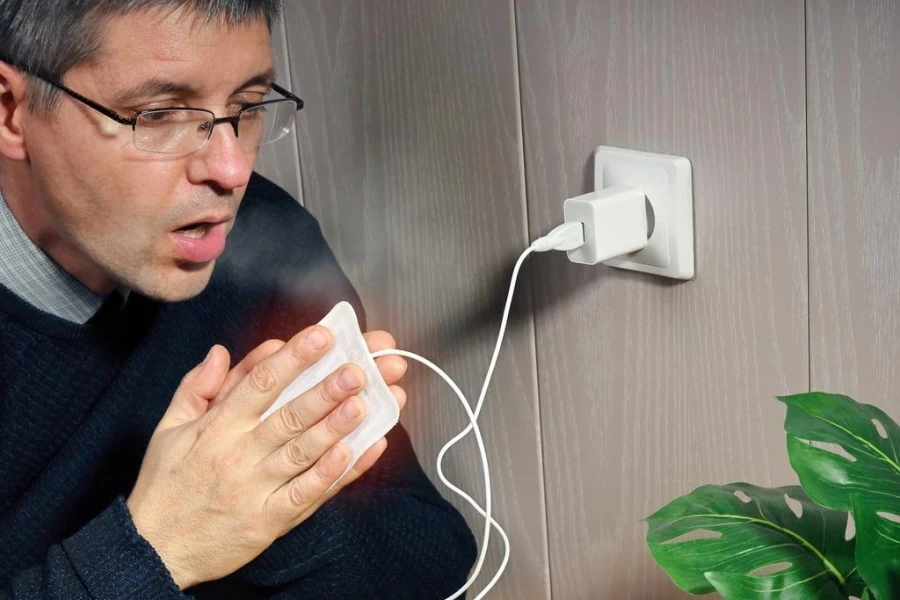Table of Contents
1. Introduction
2. Types of Hand Warmers in 2024
3. Market Trends and Developments
4. Key Factors to Consider When Choosing
5. Conclusion
Introduction
Hand warmers offer a convenient way to combat cold conditions, whether outdoors or in chilly environments. These small, portable devices deliver heat to keep hands comfortable and functional, making them invaluable for tasks requiring dexterity in colder climates. In 2025, advancements in heating technology and eco-friendly materials have expanded options, including disposable, rechargeable, and reusable hand warmers. Each type provides distinct benefits such as ease of use, duration of heat, and sustainability, allowing professionals to choose products based on specific performance requirements and comfort preferences.

Types of hand warmers in 2024
Disposable warmers
Disposable hand warmers remain popular for quick, one-time use. These air-activated devices offer a reliable heat source for up to 6-12 hours, making them ideal for outdoor work or short-term activities. Although convenient, they generate waste and are less eco-friendly, which might impact purchase decisions for businesses aiming to meet sustainability targets. Their low cost and wide availability, however, ensure they maintain a strong presence in the market.
Reusable gel-based warmers
Gel-based hand warmers utilize a supersaturated solution, which heats up when activated, offering a reusable option for those needing short-term warmth. They are often praised for their ability to last up to 12 hours, though they require reheating after use. These warmers are an economical choice for businesses looking to minimize ongoing costs, as they can be boiled and reused multiple times, though their heat generation might not be as fast as other options.
Rechargeable hand warmers
Rechargeable electric hand warmers have surged in popularity due to their eco-friendly and practical design. These warmers offer adjustable heat levels, often reaching up to 135°F, and can last anywhere from 4 to 14 hours on a full charge, depending on the model. An additional benefit is their ability to double as power banks, appealing to professionals who need to charge devices on the go. While these models are slightly bulkier and require longer charging times, their convenience and long-term cost savings make them a top choice for businesses in 2024.
Lighter-fluid hand warmers
Lighter-fluid hand warmers, like the Zippo models, remain a reliable option for long-lasting heat. These catalytic warmers can operate for up to 12 hours using lighter fluid, making them suitable for those working in extremely cold environments for extended periods. They don’t rely on electricity, but they require some maintenance, such as refueling and ensuring proper safety handling. While not as widely adopted as electric or disposable models, these warmers offer a powerful solution for niche markets like winter outdoor professions.
Market trends and developments

Market Growth and Projections
In 2024, the hand warmer market, initially valued at approximately $1.47 billion in 2022, was projected to grow to around $2.30 billion by 2031, reflecting a compound annual growth rate (CAGR) of 5.16% from 2022 to 2031. Key factors driving this growth include the rising popularity of outdoor activities such as skiing and hiking, along with advancements in eco-friendly and reusable technologies. Additionally, there is an increased awareness of health-related applications for hand warmers as essential cold-weather accessories, as highlighted by insights from Cognitive Market Research. This trend is further fueled by consumer interest in sustainable products that offer enhanced functionality and environmental benefits.
Eco-friendly products gaining traction
By 2025, the shift toward eco-friendly hand warmers is expected to intensify, with growing consumer and industry focus on sustainability. Traditional disposable hand warmers, once a market staple, are gradually being replaced by reusable gel packs and rechargeable options, both of which reduce waste and offer long-term value. Many companies are incorporating recyclable materials into their designs, catering to environmentally conscious consumers and aligning with broader trends toward sustainable products. Business buyers, particularly in outdoor industries, are increasingly favoring greener alternatives to meet these evolving consumer preferences.
Technological advances
Technological advancements are transforming the hand warmer market, particularly with innovations in rechargeable models. Newer hand warmers are now equipped with lithium-ion batteries and USB-C charging, enhancing both performance and convenience with features like faster charging, extended battery life, and customizable heat settings. Some models, such as those with power bank functionality, offer dual-purpose solutions that provide warmth and charge mobile devices, making them highly appealing to outdoor enthusiasts and professionals who need reliable, versatile warmth during long activities.
Key Factors to Consider When Choosing Hand Warmers

Duration of Warmth
The duration of warmth is a crucial factor when selecting hand warmers, as different types offer varying heating times. For example, disposable hand warmers typically provide heat for several hours, making them ideal for short outdoor activities like skiing or snowboarding. In contrast, rechargeable and fuel-based hand warmers are suitable for longer durations, often providing warmth for an entire day, which is beneficial for extended outdoor pursuits like camping or hiking. Users engaged in activities that require prolonged warmth may prefer options with extended heating times to ensure comfort throughout their adventure.
Portability and Ease of Use

Portability and ease of use are essential considerations, especially for individuals who frequently engage in outdoor activities. Compact, pocket-sized hand warmers are convenient for carrying during activities where hands must remain free. Additionally, the design and weight of the warmer can significantly influence usability. Rechargeable models often feature ergonomic designs and are lightweight, making them easy to handle and transport. Moreover, some hand warmers double as power banks, adding functionality for those needing to charge devices on the go. This versatility enhances their appeal for outdoor enthusiasts seeking convenience alongside warmth.
Cost-Efficiency and Sustainability
Cost-efficiency and sustainability are vital aspects of choosing hand warmers. Although disposable options are generally cheaper initially, the long-term benefits of reusable warmers often outweigh their upfront costs. Rechargeable hand warmers, for instance, may have a higher purchase price but can be reused multiple times, offering significant savings over time. Furthermore, their eco-friendly nature contributes to reducing waste, aligning with the growing consumer demand for sustainable products. Professionals in the industry should consider these factors, as offering eco-friendly, reusable options can enhance product appeal in a market increasingly focused on sustainability
Conclusion

Selecting the appropriate hand warmer is crucial for meeting specific usage needs while ensuring convenience and sustainability in 2025. Different types of warmers, whether rechargeable, disposable, reusable, or lighter-fluid models, cater to various activities and preferences. Understanding the trade-offs between heat duration, portability, and environmental impact can lead to better purchasing decisions. As the hand warmer market continues to evolve, staying informed about trends and advancements will help professionals make choices that align with both performance and eco-consciousness. Adapting to these changes will be essential for achieving lasting satisfaction and efficiency.



